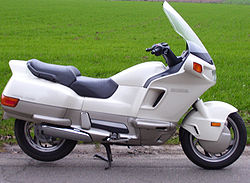 1989 Honda Pacific Coast with accessory tall windshield | |
| Manufacturer | Honda |
|---|---|
| Also called | Honda Pacific Coast |
| Production | 1989–1998 |
| Class | Touring |
| Engine | 800 cc (49 cu in) 45° 3-valves per cylinder, V-twin, liquid cooled |
| Bore / stroke | 79.5 mm × 80.6 mm (3.13 in × 3.17 in) |
| Ignition type | CDI |
| Transmission | Hydraulic clutch, 5-speed, shaft drive |
| Frame type | Steel |
| Suspension | Front 42 mm telescopic fork Rear 4-way adjustable spring |
| Brakes | Front 2x disc 290 mm, 2 piston calipers Rear drumbrake 180 mm |
| Tires | Front 120/80-17 140/80-15 |
| Wheelbase | 59.1 inches (1,500 mm) |
| Dimensions | H: 1,360 mm (54 in) |
| Fuel capacity | 16 L (3.5 imp gal; 4.2 US gal) |
The PC800 Pacific Coast is a touring motorcycle manufactured and marketed by Honda between 1989 and 1998. Named after California's Pacific Coast Highway, over 14,000 were sold in North America, Europe and Japan, with a three-year hiatus between two production runs. The bike is noted for its single integrated trunk straddling the rear wheel, full bodywork, and distinctive two-tone paint.
Like the earlier Honda Gold Wing[1] and later Rune,[2] the Pacific Coast had been conceived and designed by Honda Research America specifically for the US market. Though subsequent Honda motorcycles would feature integral, side-opening trunks—namely the Deauville/NT700V, ST1100, Gold Wing and ST1300—the wheel-straddling, top-opening trunk concept remained unique to the Pacific Coast.[3]
- ^ "The New Gold Standard - Part 2". Honda Media Newsroom. American Honda. 2003-09-02. STYLING. Retrieved 2012-07-01.
By October 1997, those sketches had evolved into one finalist. Honda R&D Asaka and Honda Research America both set about creating a 1/8th-scale clay model, an unprecedented step that underscores the project's significance. In February 1998, an internal competition selected the best aspects of the Japanese and American designs, and a final full-scale model was created.
- ^ "Honda Rune Timeline". Archived from the original on July 4, 2008.
While all four began as Honda Research America (HRA) ideas and sketches, outside sources-including a master fabricator not connected with motorcycling in any way-were also tapped in order to push the boundaries of design beyond the usual limits.
- ^ Luckhurst, Tim (14 March 2006). "Honda Deauville: One for the money". The Independent. Archived from the original on February 23, 2009.